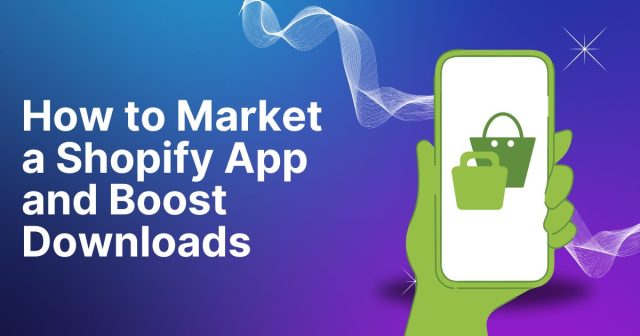Shopify is one of the leading e-commerce platforms, with more than 4.4 million stores worldwide as of 2023. As a Shopify app developer, entering this thriving ecosystem offers immense potential; however, succeeding in this competitive marketplace requires more than just building a great app. The secret lies in how effectively you market it.
This guide is designed to help Shopify app developers and marketers understand the key strategies for promoting an app, from reaching targeted merchants to optimizing app listings. Whether you’re launching a new app or looking to grow an existing one, these expert tips will help you stand out.
Understanding the Shopify App Store Market

Before jumping into marketing strategies, it’s essential to know what you’re up against. The Shopify App Store hosts more than 8,000 apps, catering to various categories like marketing, inventory management, customer support, and more. Merchants visit the App Store searching for tools to help them save time, make more sales, or enhance their stores’ functionality.
Why Marketing Matters
Even if your app solves a common pain point, merchants may not find it unless you market it effectively. A well-executed strategy ensures that potential users can locate, download, and trust your solution. From discoverability to building credibility, marketing plays a crucial role in your app’s success.
Step-by-Step Guide to Marketing Your Shopify App
1. Research Your Target Audience
Marketing starts with understanding who your app is for. Ask yourself questions like:
- Who are my ideal users?
- What problems does my app solve for them?
- How do they currently address this issue?
Shopify merchants range from solo entrepreneurs to mid-sized businesses. Adjust your tone and strategy depending on whether you’re targeting small businesses working with limited budgets or growing enterprises that need scalable solutions.
2. Craft a Compelling Value Proposition
Merchants need to understand within seconds why they should use your app. That’s where a strong value proposition comes in. Clearly articulate how your app will benefit them. For example:
- Instead of saying: “Our app automates customer emails.”
- Say this: “Save 10+ hours per week by automating your emails and increasing customer engagement with our app.”
Highlight how your app solves pain points, saves time, and offers measurable value.
3. Optimize Your Shopify App Store Listing
Your app’s listing is the first impression many merchants will have. Make it count by focusing on these key components:
- Descriptive Title: Use a clear, searchable app name. If possible, include your main feature in the title.
- Clear Description:
- Lead with benefits, not just features.
- Use a bullet point format to make it skimmable.
Example:
- Improve email open rates by 30%
- Set up automated campaigns in under 5 minutes
- High-Quality Images and Videos:
- Include demo videos to show how the app works in action.
- Add screenshots of the interface highlighting key features.
- Use Keywords:
Identify and utilize keywords that merchants might search for. Use tools like Google Keyword Planner or Ubersuggest to target terms based on search volume.
4. Leverage Reviews and Testimonials
Merchants put a lot of trust in reviews, as they are a key ranking factor and influence conversions. Some tips for gathering and displaying reviews include:
- After a merchant installs the app, prompt them for feedback after they’ve used it successfully for a few weeks.
- Offer excellent customer support to encourage positive reviews.
- Use testimonials with real metrics like “Helped us increase revenue by 40% in two months.”
5. Use Content Marketing to Educate and Attract Merchants
Showcasing your expertise in e-commerce through content marketing can help bring more users into your funnel. Here’s how to get started:
- Blog Posts:
- Write blog articles about relevant Shopify topics tied to your app’s features. For example, a productivity app could publish “Top 10 Ways to Save Time as a Shopify Merchant.”
- Video Content:
Share video tutorials, live demos, or “Tips for Shopify Merchants” on YouTube.
- Case Studies:
Document success stories from merchants who used your app and achieved results.
6. Leverage Social Media Marketing
Social media platforms like Twitter, LinkedIn, and Instagram are valuable for engaging with merchant communities. Tips for effective social media marketing include:
- Share user-generated content, like videos of merchants explaining how your app helped them.
- Run sponsored posts, promoting blog content or tutorials.
- Engage with Shopify-specific hashtags like #ShopifyTips, #EcommerceSolutions, or #ShopifyApps.
7. Partner with Shopify Experts and Influencers
Collaborate with experts and influencers who specialize in Shopify e-commerce. These partnerships can expose your app to a wider audience.
- Shopify Experts or agencies often recommend apps to their clients. Reach out to agencies that focus on Shopify development and show how your app aligns with their needs.
- Influencers in the e-commerce niche can demo or review your app on YouTube or Instagram, lending credibility.
8. Use Paid Advertising Strategically
Both Google Ads and Shopify App Store Ads are excellent options for driving traffic to your app. Some tips include:
- Use keywords from your app listing to target search ads.
- A/B test ad variations to see what resonates most.
- Highlight your app’s value proposition in the ad copy.
9. Offer Promotions and Free Trials
Merchants love trying products before committing, and a free trial can help ease hesitations. Consider offering the following:
- A 14-day free trial allows merchants to explore your app risk-free.
- Discount codes for first-time subscribers.
- Referral programs reward users for recommending your app.
10. Provide Top-Tier Support
Exceptional customer support can be a powerful marketing tool on its own. Merchants who encounter helpful, reliable assistance are more likely to leave positive reviews, share your app with others, and remain loyal.
- Create an FAQ section to handle common queries.
- Offer live chat or a dedicated email where users can reach you.
- Follow up to ensure unresolved issues from trials or feedback forms get addressed.
Reaching the Next Level with Marketing Strategies

Marketing your Shopify app is an ongoing process that doesn’t end after a successful launch. By combining optimized app listings, targeted content, and strong word-of-mouth campaigns, you can continually attract merchants seeking solutions to business challenges.
It’s important to test, analyze results, and refine your approach over time. Keep an eye on what’s working and focus your efforts there, while consistently staying updated with Shopify’s latest trends and policies.




